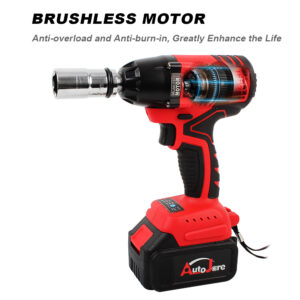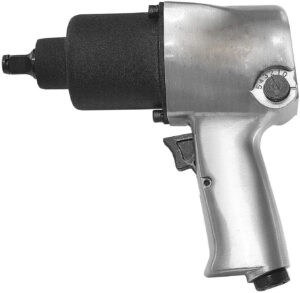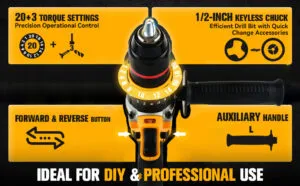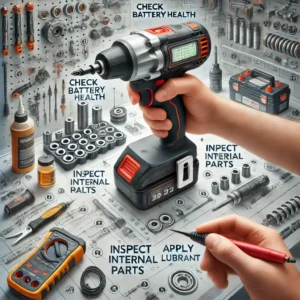When it comes to impact wrenches, it’s important to know the differences between corded, cordless, and pneumatic models so you can make an informed decision that’s right for you, whether you’re a professional or a DIYer. Each type has its own advantages and disadvantages depending on what you’re doing.
Corded Impact Wrenches
Corded impact wrenches are a vital tool for various applications, from automotive repair to construction projects. Their primary advantage lies in their consistent power output, which is directly sourced from an electrical outlet. This ensures that they can deliver a steady level of torque throughout their use, without the drop in performance associated with battery depletion in cordless models or the need for an air compressor as in pneumatic types.
Key Features :
- Consistent Power Supply: Unlike cordless impact wrenches, corded impact wrenches benefit from a continuous power supply, which means you can work with them for as long as you want without having to stop and recharge batteries. This is especially useful if you’re working on a long project or if you’re working in a stationary setup.
- High Torque Output: In general, corded impact wrenches can deliver higher torque outputs than cordless models, which makes them great for tasks that require a lot of force, like loosening really tight bolts or nuts.
- Durability: Corded impact wrenches usually last longer than cordless models because they have fewer moving parts like batteries and complex electronics. This makes them a reliable tool for professional use.
- Cost-Effectiveness: Corded impact wrenches usually cost less up front than cordless models because you don’t have to buy expensive batteries or chargers. And the ongoing cost is also less because you don’t have to replace or upgrade batteries.
Limitations
- Mobility and Range: The main drawback of corded impact wrenches is that they have a limited range of motion because of the power cord. This can make them less than ideal for applications that require mobility or access to tight spaces far from power outlets.
- Work Area Constraints: The dependency on an electrical outlet can sometimes constrain the work area to locations where power is readily available, potentially requiring the use of extension cords to reach more distant workspaces.

Cordless Impact Wrenches
Cordless impact wrenches are a major advancement in power tools, offering a mix of portability, power, and convenience that’s tough to beat with corded or pneumatic options.
The Rise of Cordless Impact Wrenches
With the advent of high-capacity rechargeable batteries, cordless impact wrenches have become increasingly popular among professionals and DIY enthusiasts alike. Powered by lithium-ion batteries, these tools are known for their long life, fast charging times, and ability to hold a charge for extended periods. The evolution of battery technology has significantly narrowed the performance gap between cordless models and their corded or pneumatic counterparts.
Advantages of Cordless Impact Wrenches
- Portability: The standout advantage of cordless impact wrenches is their portability. Without needing a power outlet or air compressor, these tools can be used virtually anywhere, making them perfect for field repairs, construction sites, and home projects.
- Ease of Use: The lack of cords or air hoses greatly reduces tripping hazards and enhances ease of use, especially in tight spaces or when working at awkward angles.
- Power and Efficiency: Modern cordless impact wrenches are designed to deliver high torque output that rivals corded models, making them suitable for a wide range of tasks, including automotive repairs, construction projects, and equipment maintenance.
- Variable Speed and Power Settings: Many cordless impact wrenches come with adjustable speed and power settings, allowing users to tailor the tool’s performance to specific tasks, thereby minimizing the risk of damage to workpieces or fasteners.
Considerations and Drawbacks
- Battery Dependency: The reliance on batteries means that the performance of a cordless impact wrench can be limited by battery life. For extended use, you may need spare batteries or plan for regular recharging breaks.
- Cost: Initially, cordless impact wrenches can be more expensive than their corded or pneumatic counterparts, mainly due to the cost of batteries and charging technology. However, the investment can be justified by the convenience and versatility they offer.
- Weight: The addition of a battery can make cordless impact wrenches heavier than pneumatic models, which could lead to user fatigue over prolonged periods.
Ideal Applications
Cordless impact wrenches are exceptionally versatile, making them suitable for a variety of applications, including:
- Automotive Repair: Ideal for loosening or tightening lug nuts, engine bolts, and other automotive fasteners, especially in situations where mobility is key.
- Construction and Assembly: Useful for constructing metal frameworks, assembling furniture, and working on projects where power sources are not readily available.
- Home Maintenance and DIY Projects: From building decks to repairing appliances, cordless impact wrenches offer the power and flexibility needed for a wide range of home projects.
Cordless impact wrenches combine the mobility of pneumatic wrenches with the power of corded models, all without the limitations of cords or air hoses. As battery technology continues to improve, these tools are set to become even more powerful and efficient, further solidifying their place in the toolkits of professionals and hobbyists alike. For anyone in need of a high-torque tool that offers convenience and versatility, a cordless impact wrench is an investment worth considering.

Pneumatic Impact Wrenches
Pneumatic impact wrenches, also known as air impact wrenches, are powerful tools commonly used in automotive, construction, and heavy equipment maintenance industries. These wrenches operate on compressed air supplied by an air compressor, converting high-pressure air into mechanical energy to deliver high torque output with minimal effort from the user.
How Pneumatic Impact Wrenches Work
The core of a pneumatic impact wrench’s functionality lies in its design, which typically involves a rotating mass (hammer) being accelerated by the motor (driven by compressed air), then suddenly connected to the output shaft (anvil), creating a high-torque impact. This mechanism allows for the delivery of very high torque without the kickback one might expect from such powerful force, making these tools ideal for loosening or tightening bolts and nuts that require significant force.
Advantages of Pneumatic Impact Wrenches
- High Power and Efficiency: Pneumatic impact wrenches deliver very high torque output, far surpassing electric models in terms of raw power. This makes them ideal for heavy-duty applications where high torque is necessary.
- Durability and Reliability: With fewer moving parts than their electric counterparts, pneumatic wrenches tend to have a longer lifespan and can withstand rigorous use in demanding environments.
- Lightweight Design: Despite their power, pneumatic impact wrenches are generally lighter than equivalent electric models, reducing user fatigue during extended use.
- Cost-Effectiveness: For workshops and industries already equipped with an air compressor system, adding pneumatic tools can be more cost-effective than investing in multiple electric or battery-powered units.
Considerations for Using Pneumatic Impact Wrenches
- Dependence on Air Compressor: The need for a continuous supply of compressed air means these tools cannot be used without access to an air compressor, limiting their mobility and requiring additional investment in air compressor infrastructure.
- Noise and Air Quality: Pneumatic tools can be noisy and may introduce oil mist or other contaminants into the air, necessitating appropriate hearing protection and ventilation in workspaces.
- Maintenance: While generally durable, pneumatic impact wrenches and air compressor systems do require regular maintenance to ensure optimal performance and longevity.
Applications of Pneumatic Impact Wrenches
Pneumatic impact wrenches are exceptionally versatile and can be used in a wide range of applications, including:
- Automotive Repair and Maintenance: Ideal for loosening lug nuts, engine bolts, and other automotive fasteners that require high torque.
- Construction: Useful in the assembly and disassembly of scaffolding, structural steel, and other high-torque construction applications.
- Heavy Equipment Maintenance: Essential for servicing large machinery in mining, agriculture, and manufacturing, where their power can significantly reduce downtime.
Pneumatic impact wrenches are renowned for their high power, efficiency, and durability, making them a staple in industrial and automotive settings. While the need for an air compressor may restrict their use in certain situations, the advantages they offer in terms of performance and reliability make them an indispensable tool for professionals seeking high-torque solutions. With proper maintenance and care, a pneumatic impact wrench can be a long-lasting addition to any tool collection, delivering unparalleled power and efficiency for a wide range of tasks.

Table 1: Comprehensive Comparison with Advantages, Disadvantages, and Mobility
| Type | Power Consistency | Maximum Torque | Portability | Durability | Energy Efficiency | Ease of Use | Best for | Disadvantages | Mobility |
|---|---|---|---|---|---|---|---|---|---|
| Corded | Very High | High | Low | High | Moderate | Easy | Continuous applications in fixed locations | Limited by power cord length; Requires power outlet | Restricted |
| Cordless | High | Medium-High | Very High | Medium | Low | Very Easy | Varied tasks without constant power supply | Battery life may limit use; Higher initial cost due to batteries | Unrestricted |
| Pneumatic | Extremely High | Very High | Medium | Very High | High | Moderate | Industrial tasks requiring high durability | Requires air compressor and setup; Less portable than cordless | Limited |
Conclusion
The choice between corded, cordless, and pneumatic impact wrenches depends on the specific requirements of the task, including the need for mobility, power sources, and duration of use. Corded wrenches provide continuous power for extended use, cordless wrenches offer mobility and convenience for tasks in various locations, and pneumatic wrenches deliver high performance and durability for demanding industrial applications. Understanding these differences allows users to select the most suitable impact wrench, balancing power, mobility, and cost to achieve the best outcome for their projects.



